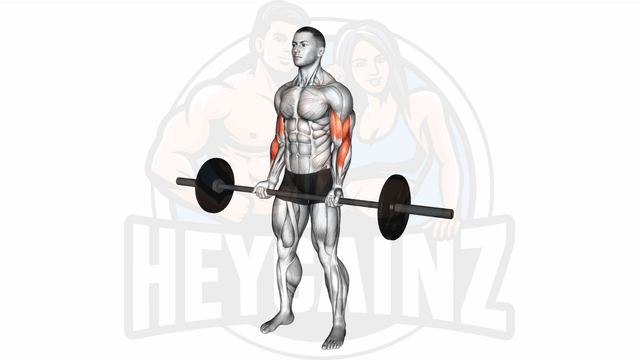
Instructions:
- 1Stand up straight with a barbell, palms facing forward
- 2Keeping the elbows close to the torso, curl the weights while contracting your biceps
- 3Raise the weights until your biceps are fully contracted and the barbell is at shoulder level
- 4Hold this position for a short pause, then slowly bring back the barbell to starting position
Tips:
- Do not use your back or shoulders to lift the weights; your hands should be the only thing moving
- Perform the exercise slowly for maximum effectiveness
- Focus on the bicep muscle while lifting to ensure correct form
- Avoid swinging the barbell to maintain control
Barbell Curl: A Comprehensive Guide
The barbell curl is a highly effective exercise targeted primarily at the biceps brachii, making it a popular choice among fitness enthusiasts. This exercise not only helps in developing upper arm strength but also enhances muscle definition. Incorporating barbell curls into your routine can lead to impressive gains, especially when done with proper form.
Understanding the Barbell Curl
When performing the barbell curl, it is crucial to maintain the correct barbell curl form. Begin by standing with your feet shoulder-width apart, holding the barbell with an underhand grip. As you lift the barbell towards your shoulders, keep your elbows close to your body and avoid swaying your back. A failure to maintain proper form can lead to injury and reduce the effectiveness of the exercise.
Muscles Worked
The primary muscle worked during the barbell curl is the biceps brachii. Additionally, this exercise engages the brachialis and brachioradialis muscles, contributing to overall arm strength and stability. Understanding the barbell curl muscles worked can help you appreciate the value of incorporating this movement into your fitness regimen.
Barbell Curl Variations
If you're looking to diversify your workout, there are several barbell curl alternatives to consider. Options like the EZ bar curl can reduce strain on the wrists and still effectively target the biceps. Additionally, barbell curl 21s offer a unique approach by incorporating partial and full ranges of motion, providing a different stimulus to the muscles.
Barbell Curl Standards and Comparisons
For those aiming to track their progress, barbell curl standards can be a helpful benchmark. Comparing the barbell curl vs dumbbell curl reveals unique benefits, as each variation offers distinct challenges and muscle activation patterns. While the barbell curl allows for heavier weights, the dumbbell curl promotes unilateral strength and muscle balance.
Tips for Success
- Start with a manageable weight to master your form before progressing to heavier loads.
- Consider using a barbell curl bar to change your grip and experience less wrist strain.
- Maintain a controlled tempo; aim for 2 seconds up and 2 seconds down for each rep.
- Incorporate barbell curls into your arm training routine 1-2 times a week for optimal results.
Whether you're a beginner or an experienced lifter, perfecting the barbell curl can enhance your upper body strength and overall physique. Remember to listen to your body and adjust your weights and repetitions based on your individual fitness goals.